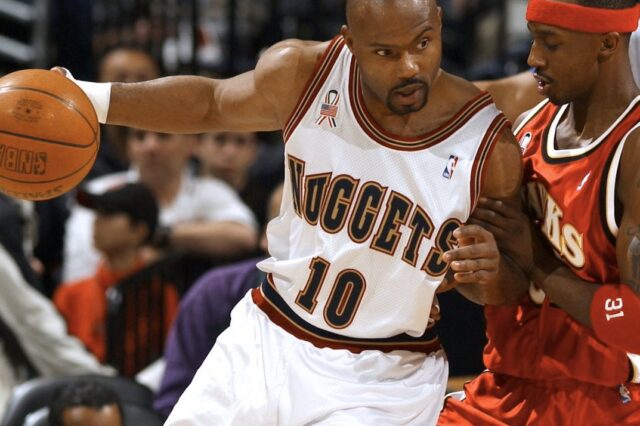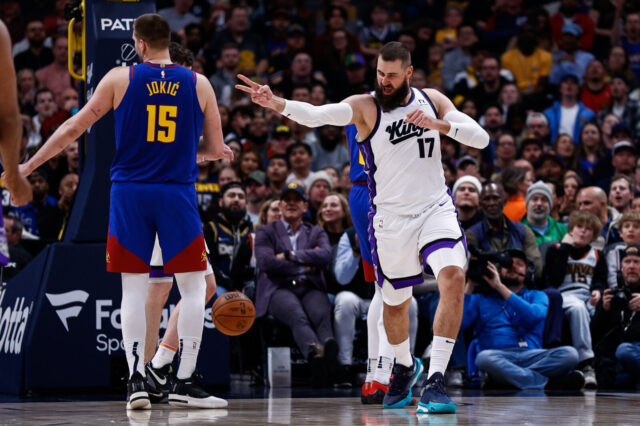At this stage in the franchise’s on-court development, the Denver Nuggets are beginning to possess more answers than questions about their ceiling.
They have a franchise cornerstone in point-center Nikola Jokic. They have two solid guards in Jamal Murray and Gary Harris, the former showcasing a star ceiling, the latter showcasing a high floor. They have two additional solid pieces in Paul Millsap and Will Barton. Millsap provides excellent contributions on defense, an extra hand to stir the offensive drink, and veteran perspective. Barton provides extra creation on the wing, either as the fifth starter or the leader of a second unit.
Beyond that though, the future contributors are less certain. Barton himself is a free agent, and if the Nuggets expect him to leave, there will be a huge hole to fill. Wilson Chandler may leave as well, though the Nuggets won’t miss what he provides as much. The most likely piece to be around for multiple years is Mason Plumlee, but more so due to his contract. The Nuggets struggled with bench contributions the entire year, and Plumlee, while the most consistent of the bunch (other than Barton), was partially to blame for that.
There are a slew of young players that were consistently inconsistent with their rotation standing in forward Juancho Hernangomez, big man Trey Lyles, and wing Malik Beasley. They may be back and a part of things, but there’s a non-zero chance they are used in trades to improve the roster or improve its salary structure. Devin Harris and Torrey Craig were in the rotation at the end of the year, but both are free agents, Harris unrestricted and Craig restricted.
This content is no longer available.
The primary point of running through the roster is that one hole stands out like a sore thumb, especially if Will Barton, Wilson Chandler, and Torrey Craig all depart, and that’s the small forward position. Even if they stay, there’s an argument that none of the above three have the talent or the stature to be a starting small forward in the NBA. Barton is the closest, but he’s also the smallest. Chandler as slowed and his skill set as a ball handler has worsened, pointing him starkly in the direction of power forward instead. Craig is simply unproven as a starter, and he shot 29.3% from beyond the arc, which simply can’t happen from a wing in today’s NBA.
Given such uncertainty, the Nuggets have work to do this offseason. Denver can improve their team via multiple mediums, but the healthiest option long term is to satisfy the problem in the draft. I was famously on the “draft OG Anunoby if you can” bandwagon last year, and while he still has his flaws, he’s current starting for the first seed in the East and operating as the primary defender on John Wall. That would have helped this year.
The good news is: the 2018 draft class is chalk full of wings. I mentioned it last week in my first 2018 NBA mock draft, in which there were 17 players selected in the first round that will spend significant time on the perimeter. Not all of them will be good, as is the case in every draft class, but it stands to reason that drafting a wing this year is smart for a number of reasons. Because the Nuggets have a need there, the decision making process becomes simpler.
Which wing should the Nuggets focus on though? Because of the vast number of wing prospects, the Nuggets will have work to do in identifying the correct player to fit their needs. But what are their true needs at the wing position this year?
Informal Checklist of traits the Nuggets may desire in their wing prospect:
- Size and Athleticism always helps. Denver’s guards are 6’4 and under, and in a league where switch-ability matters and wings handle the ball frequently, finding a player to match up physically will improve Denver’s ceiling. If that player also uses their size effectively: bonus points.
- Defensive mentality is important. The Nuggets ranked 26th in defensive rating this past season, so finding players who can help change the culture and accept defensive coaching while consistently applying that on the court will only improve said rating.
- Shooting efficiency in the right places is also important.
This is where Moneyball kicks in, so pay attention.
The three most valuable places to take shots on the court are attempts at the rim, three-pointers in the corners, and trips to the free throw line. College players that perform well in these areas generally translate those skills to the NBA (more on that in the future). Where teams struggle sometimes is evaluating certain players and how their shooting will translate to a tougher league. Proper scouting is needed, and mechanical flaws can be major indicators of initial struggles (see: Emmanuel Mudiay and Lonzo Ball), but ultimately with wings, college sample size usually wins out.
With that in mind, I want to explore how these wings performed this past season as perimeter shooters. Not just from behind the college three-point line, but behind the NBA three-point line as well. The Stepien has done a great job compiling shot charts for as many draft prospects as possible, including all college players with an initial first round peg. With the help of this data, I went through and compiled a list of wings and their total three-pointers versus their NBA range three-pointers.
This content is no longer available.
It’s easy to identify players simply using efficiency, and four stand out: Mikal Bridges, Zhaire Smith, Shake Milton, and Khyri Thomas were the four wings to crack 40% efficiency on their total attempts and 38% on their NBA attempts. Jacob Evans was a close finisher here. Troy Brown and Bruce Brown both struggled all around with their efficiency this season, while Rawle Alkins and Lonnie Walker graded poorly at NBA range as well.
Where the interesting takes occur are the guys that can be pegged for consistency versus guys that may have the ability to reach another level. Kevin Knox and Jacob Evans both shot better from NBA range than from college range this season. Both Kentucky and Cincinnati struggled at times to space the floor for these two, who were primary scoring options on their teams. Imagining them as floor spacers changes the complexion of their evaluations and makes for an interesting discussion.
Another important piece of the puzzle is how these players performed at the rim and behind the NBA arc together. Players that understand and excel at both categories would help Denver remain spaced at all times, which became a problem in certain lineup configurations due to a lack of wing talent.
Here’s the same list of players and how they performed at the rim and behind the NBA arc.
This content is no longer available.
The two columns on the left are the same as the first table’s second group of columns, but included is the efficiency percentile among wings. The next set of data involves more data from shot charts on The Stepien.
Very few wing prospects in this class were poor finishers at the college level, but three who were: Lonnie Walker, Shake Milton, and Bruce Brown. Walker and Brown both struggle from behind the NBA arc as well, so those are two guys that I’m crossing off for Denver in terms of “fit” among wings. At least Milton can shoot. He may even be the best shooter in this draft class. Better than Trae Young.
In terms of the best finishers at the rim based on the college data, the four that stand out most are Troy Brown, Zhaire Smith, Khyri Thomas, and Keita Bates-Diop. Brown is listed as a guard, but he’s listed at 6’7, 215 pounds with a 6’11 wingspan. He’s versatile and will rise up draft boards, as he had this to say on his current draft stock after declaring for the NBA draft earlier this month:
“I think my shooting ability will surprise some people,” Brown said. “I shot 75% from the line and I’m working every day to continue to improve. Being so young still and putting in the work is going to yield results, so I fully expect to shoot it better than some people might currently anticipate.” (ESPN)
Good enough for me.
Smith, Thomas, and Bates-Diop are intriguing for different reasons. Smith is currently the juicy news for NBA teams, as he rates well with analytics, plays smart basketball, and as can be seen by the above shooting numbers, is insane in the Moneyball zones. Thomas is a name to watch out for as well. He’s a pesky defender, and if his college efficiency is legit, he’s vastly underrated, though also undersized to play the small forward position in Denver. Bates-Diop certainly isn’t, as the 6’7, 235 pound forward would be suited to match up with the toughest wings to guard in the NBA and at least challenge them more than Denver’s current ensemble.
Finally, free throw percentages are important as is getting to the line frequently enough for it to matter. The next table shows total three-point shooting throughout the prospect’s career, along with the career free throw percentage and free throw rate.
(Luka Doncic is excluded from this section due to a lack of data at this point.)
This content is no longer available.
The players that I trust to maintain their college career three-point shooting at the NBA level are the players with greater than 300 attempts. Mikal and Miles Bridges, Jacob Evans, Shake Milton, and Keita Bates-Diop. For Khyri Thomas, the free throw percentage concerns me, though he could also maintain excellent three-point shooting.
For players with under 300 attempts, there is more margin for error, but also margin for improvement. It shouldn’t be automatically assumed that Knox, Troy Brown, and Zhaire Smith will struggle shooting at the NBA level. As freshman declaring, they are still incredibly young and have potential to change the narrative. That being said, they possess more risk if the goal is to find a competent 3&D prospect at small forward.
In the end, the draft class of wings is deep and versatile. There are a lot of guys who will end up being solid pros, which is encouraging for the Nuggets in that all they truly need is a guy to fill a smaller role.
In terms of the potentially three best shooters from the perimeter:
- Shake Milton
- Mikal Bridges
- Jacob Evans
In terms of the potentially three best finishers at the rim:
- Zhaire Smith
- Khyri Thomas
- Troy Brown
In terms of the potentially three most valuable free throw shooters:
- Mikal Bridges
- Shake Milton
- Kevin Knox
My personal favorite from a Moneyball perspective is Mikal Bridges. Many know my affinity for the Villanova star, and it’s unsurprising that he’s risen as high as he has, most likely outside of Denver’s reach at 14. He would be a guy I target at all reasonable cost, as he fits a need and is probably the safest pick in the entire draft.
Still, if he’s not available, there are a number of options. I’m excited to see how the draft unfolds. All I know is that the Nuggets need a versatile wing, and if they find the right one, the core of Jokic, Murray, and Harris may be able to take the next step from tantalizing talent to championship-caliber core.
This content is no longer available.


